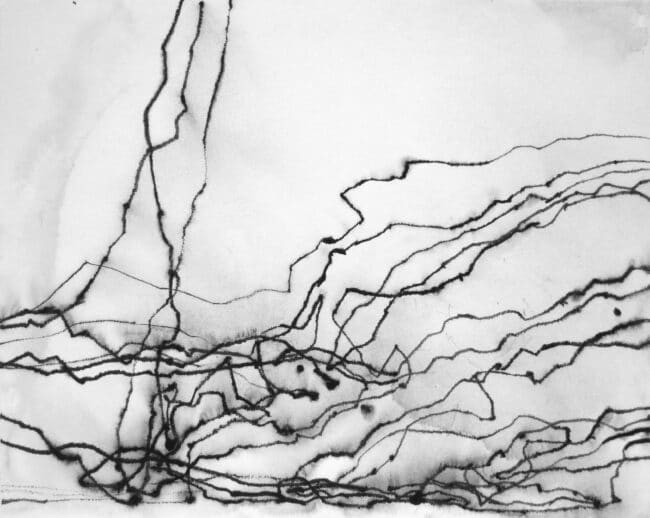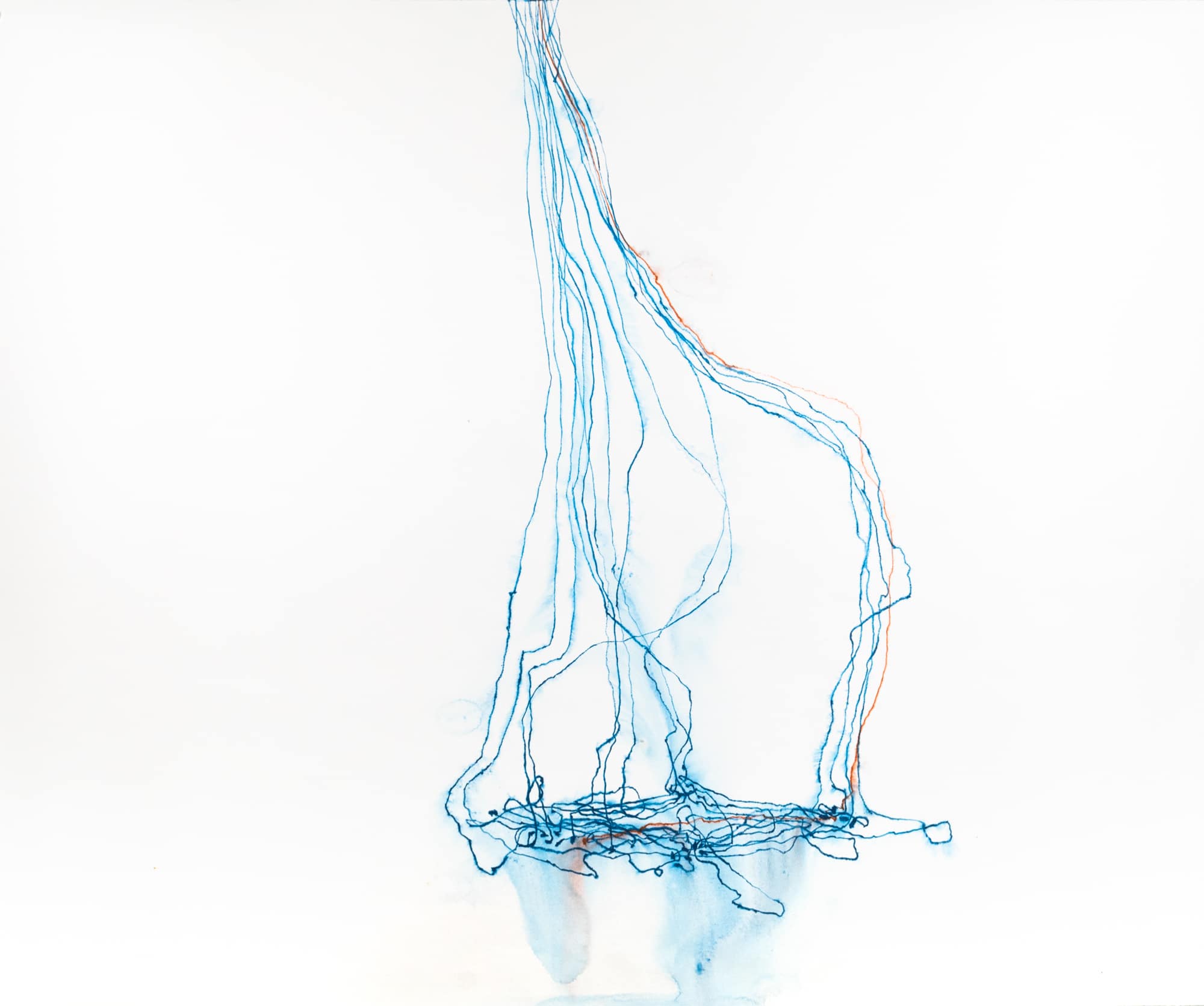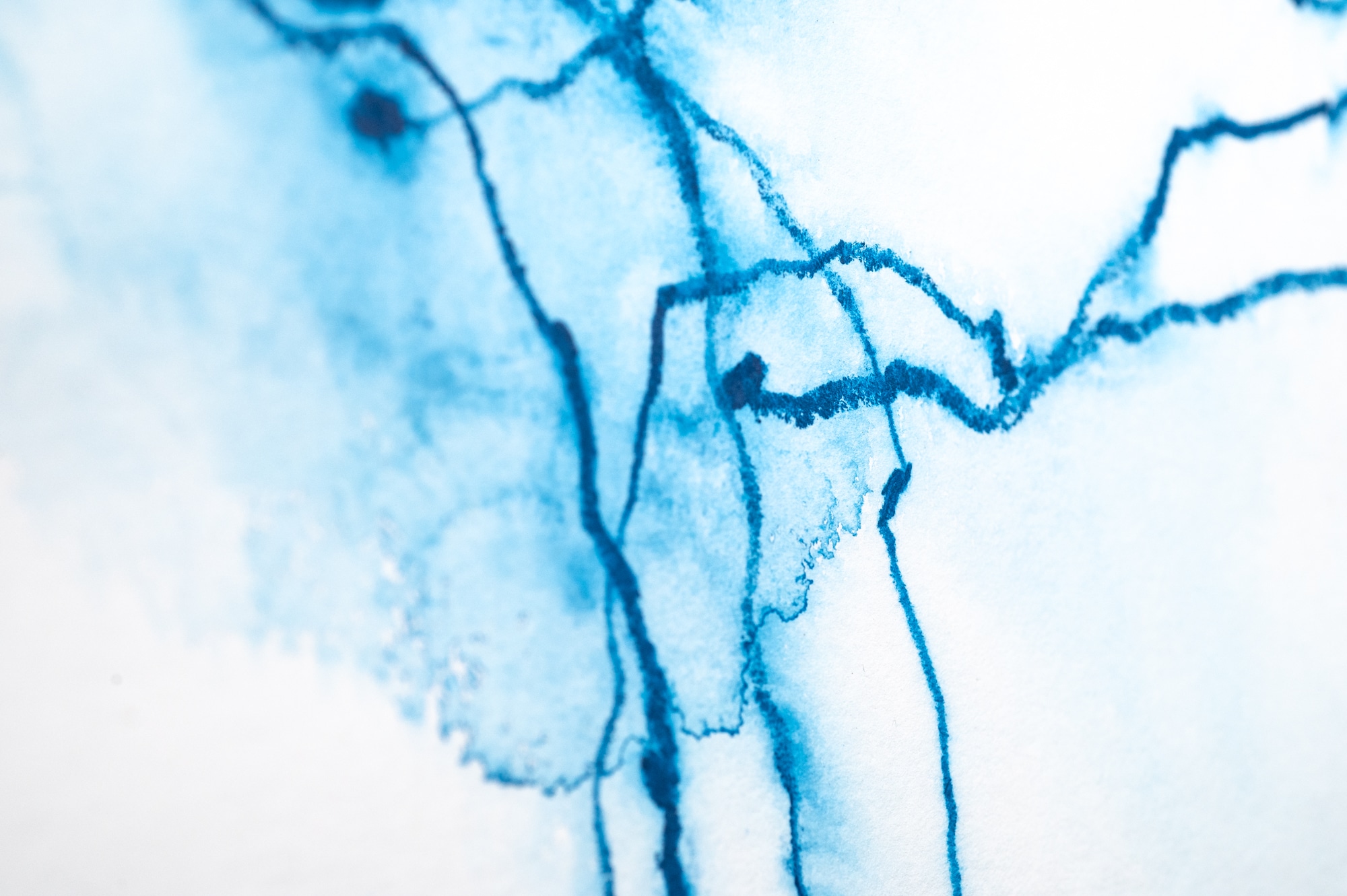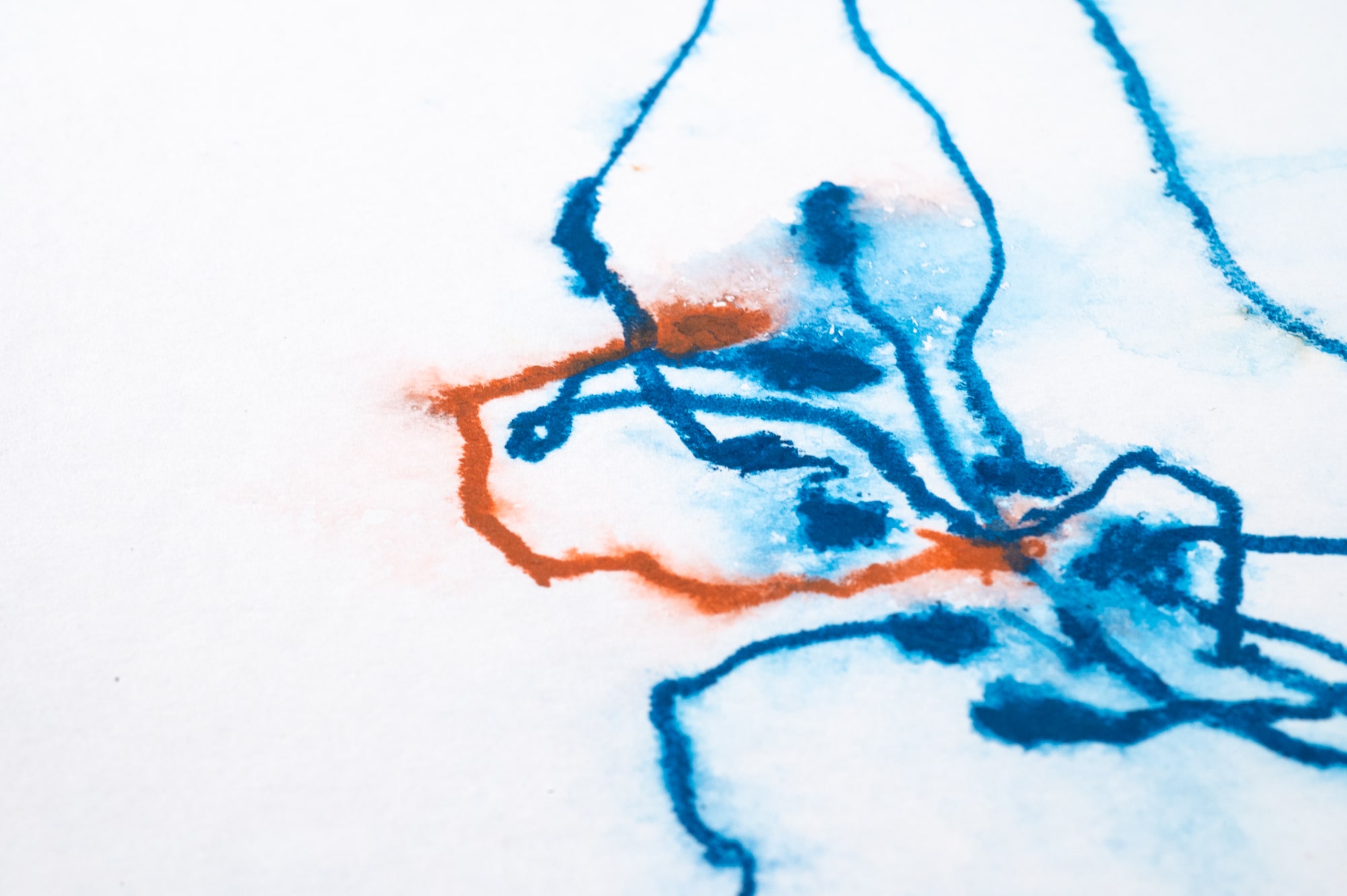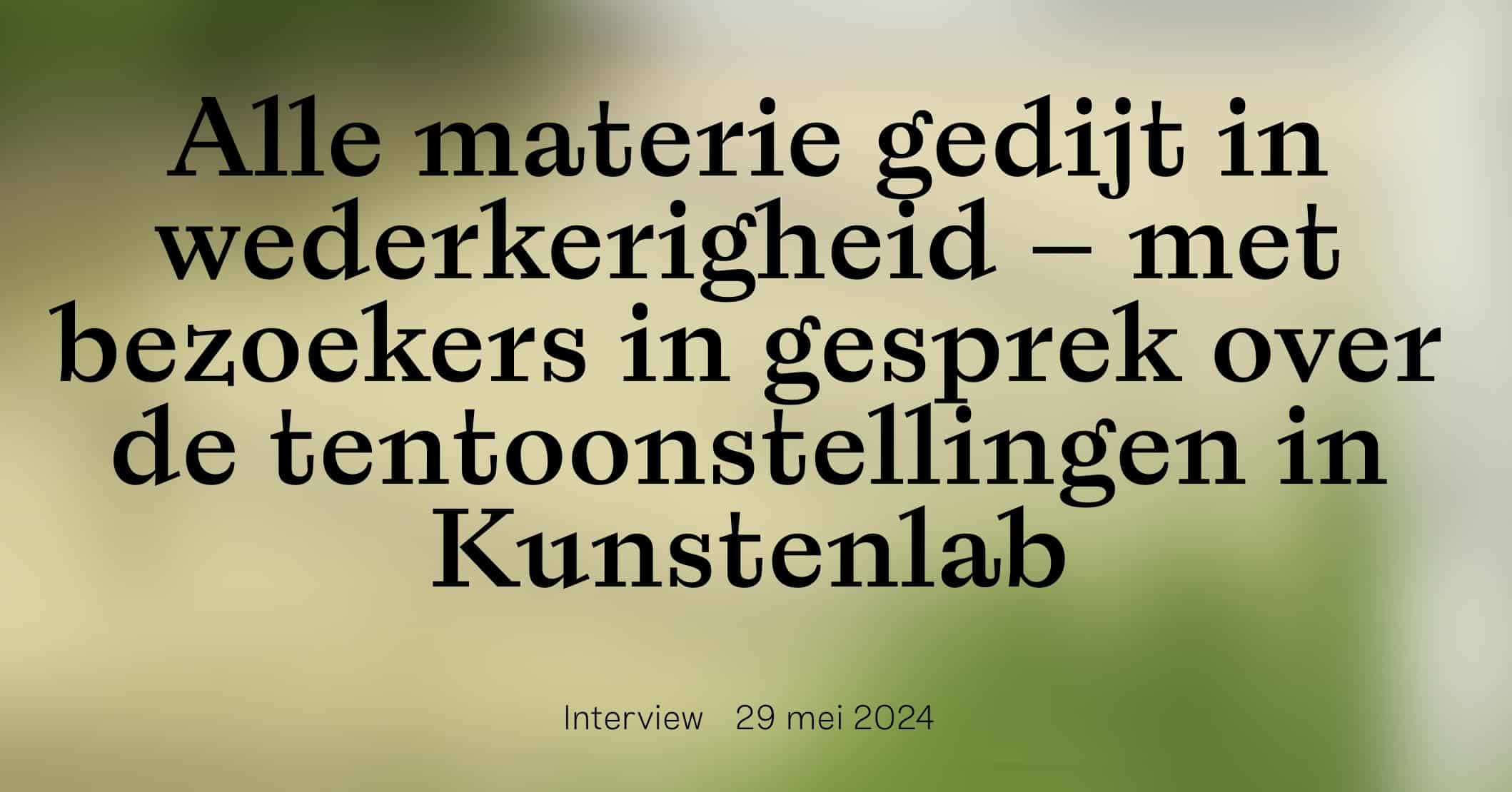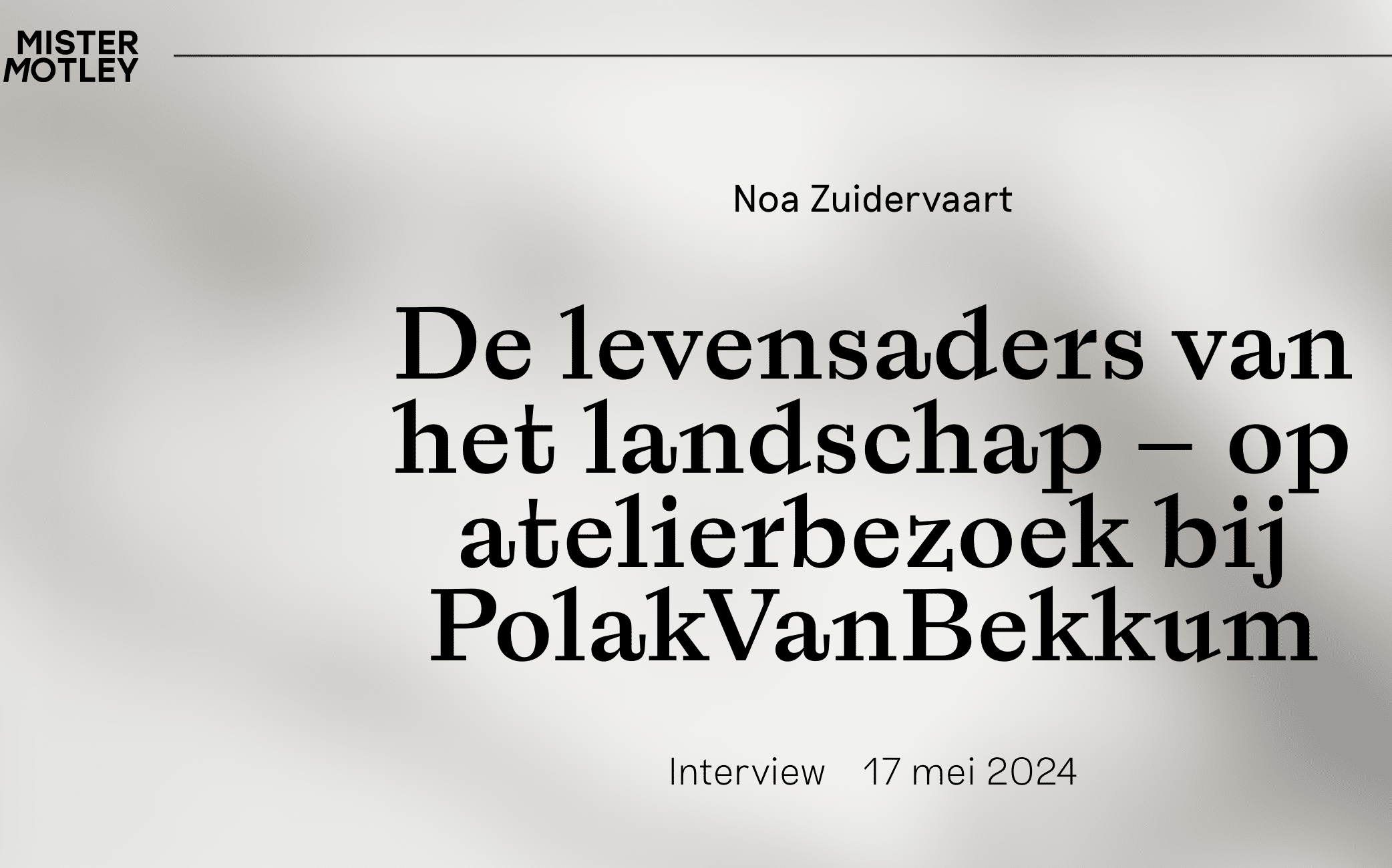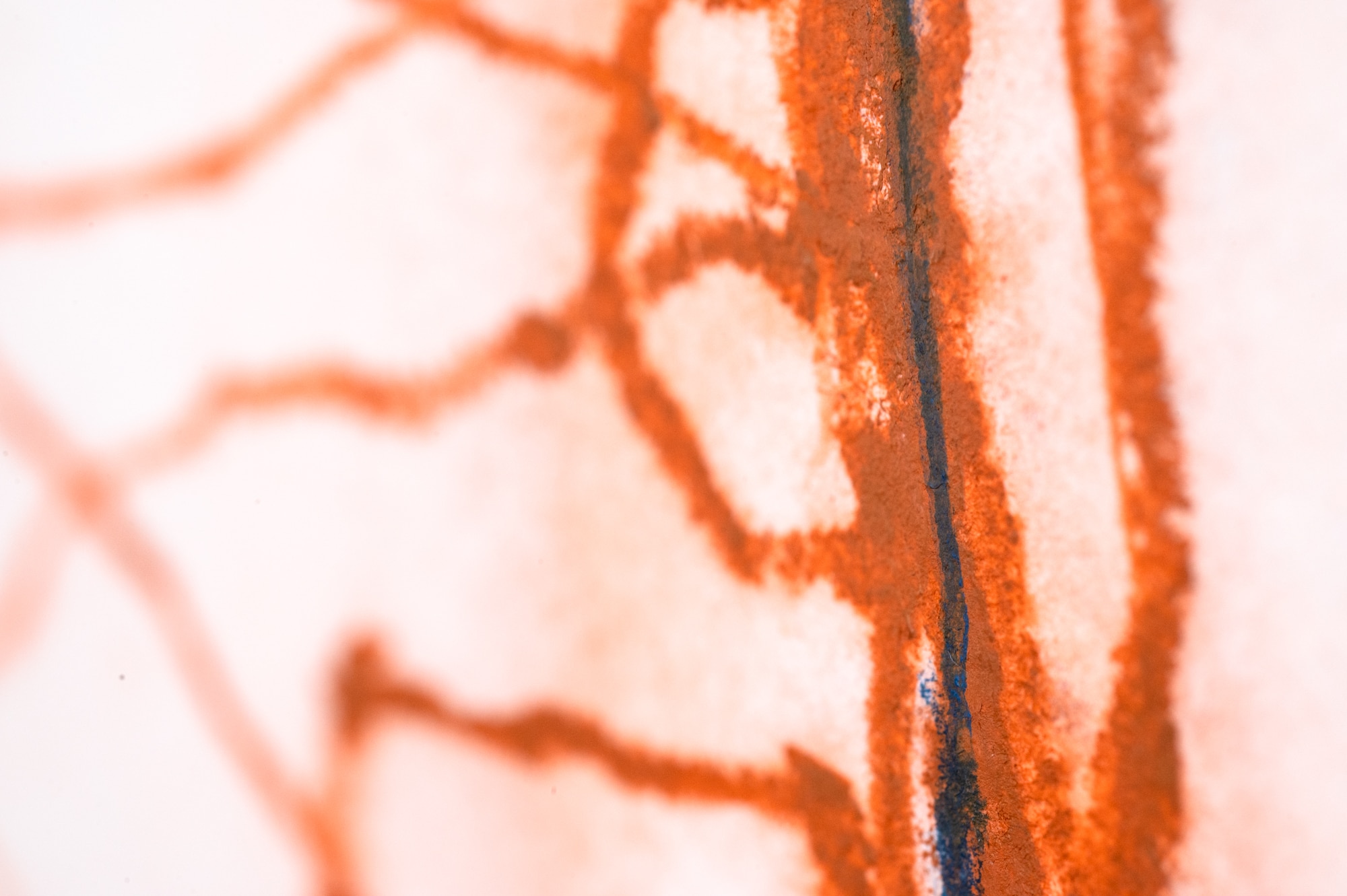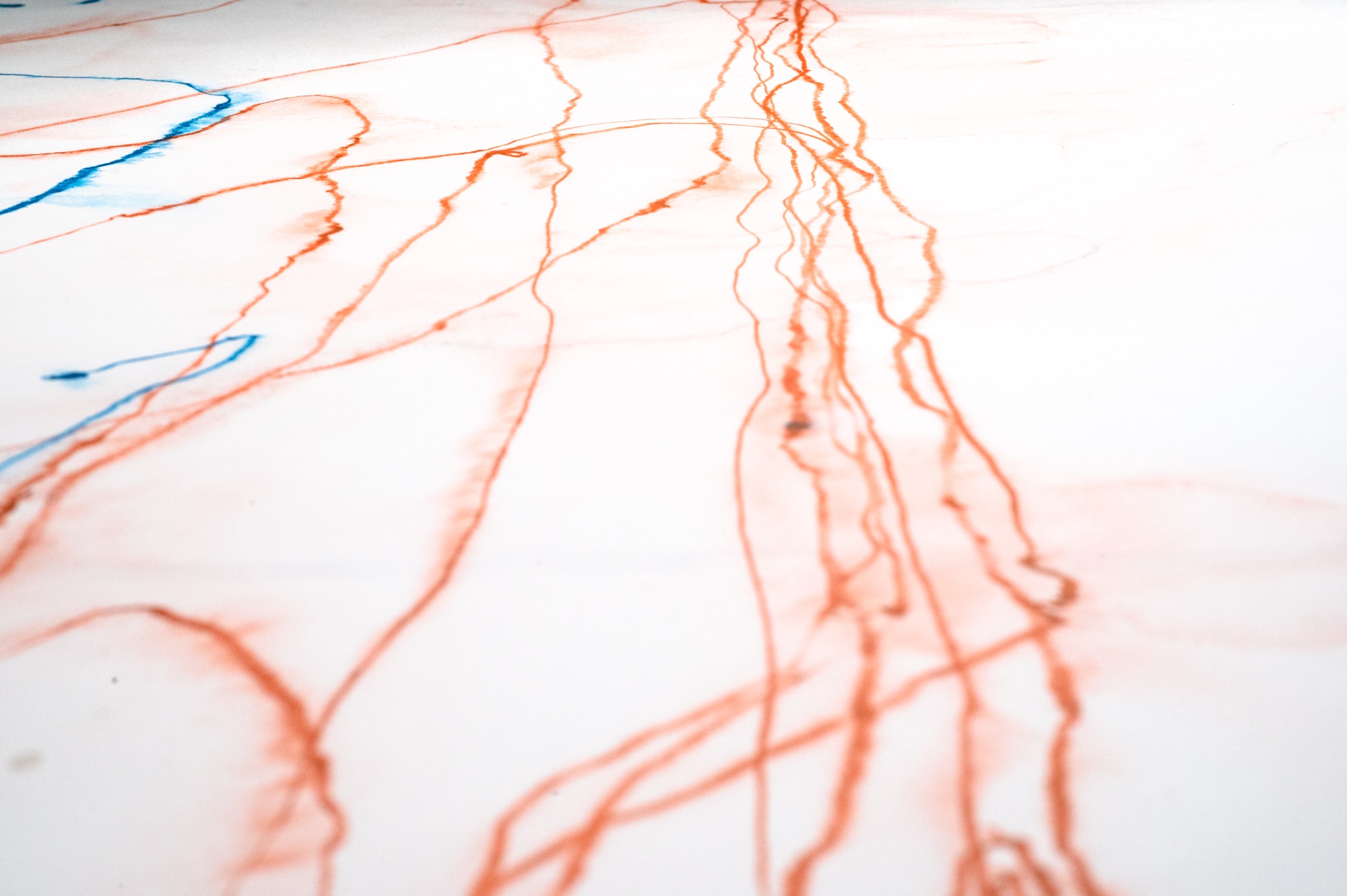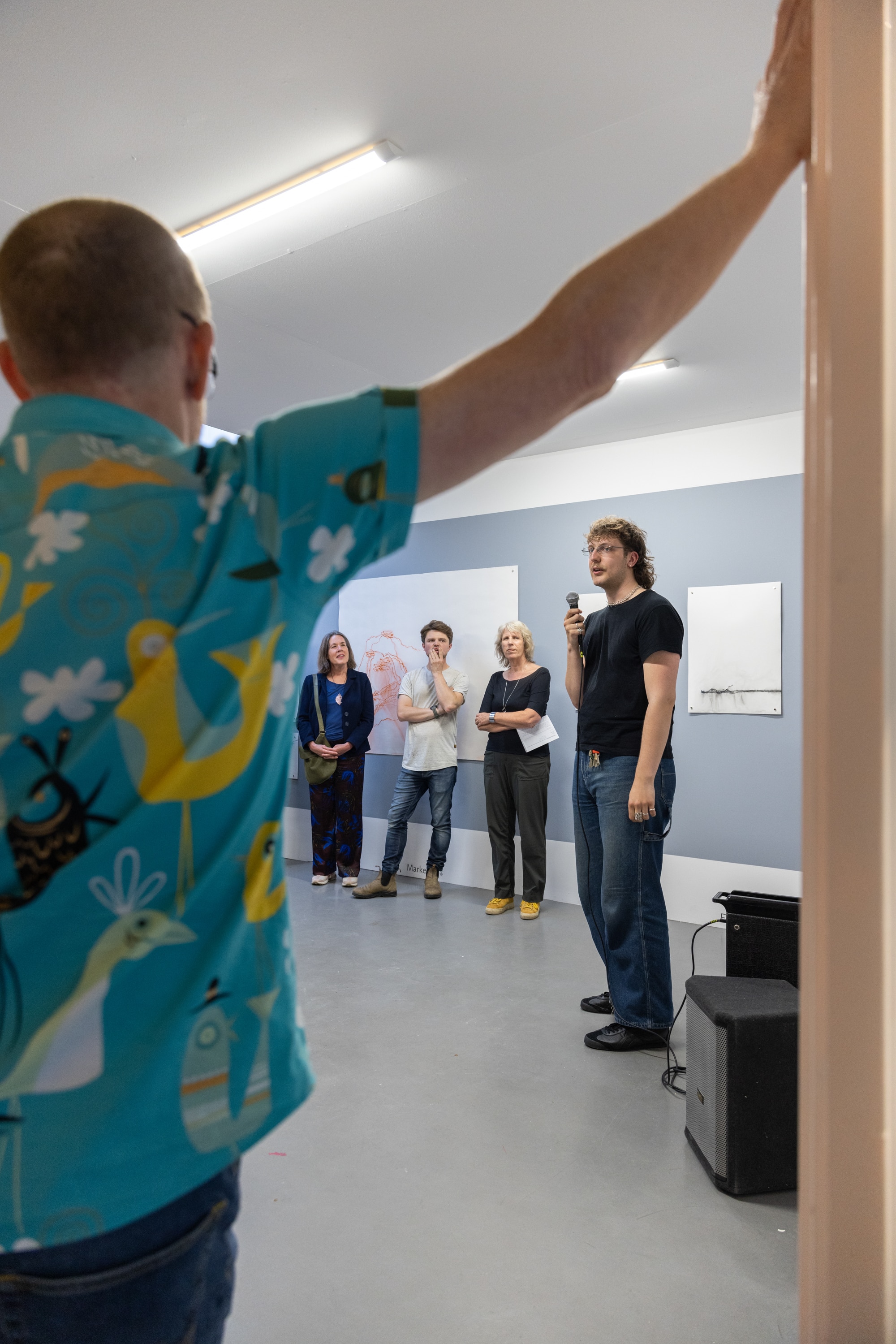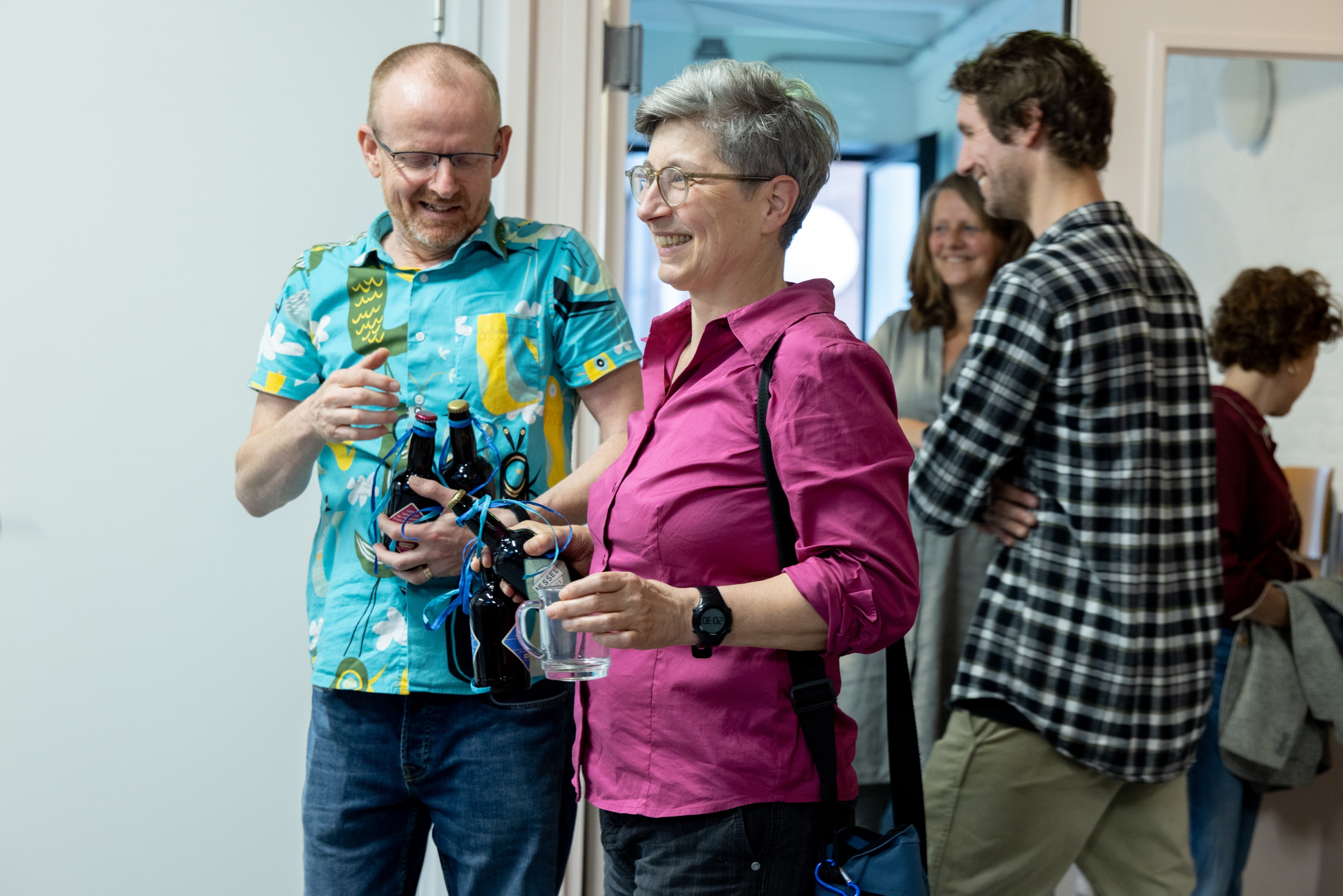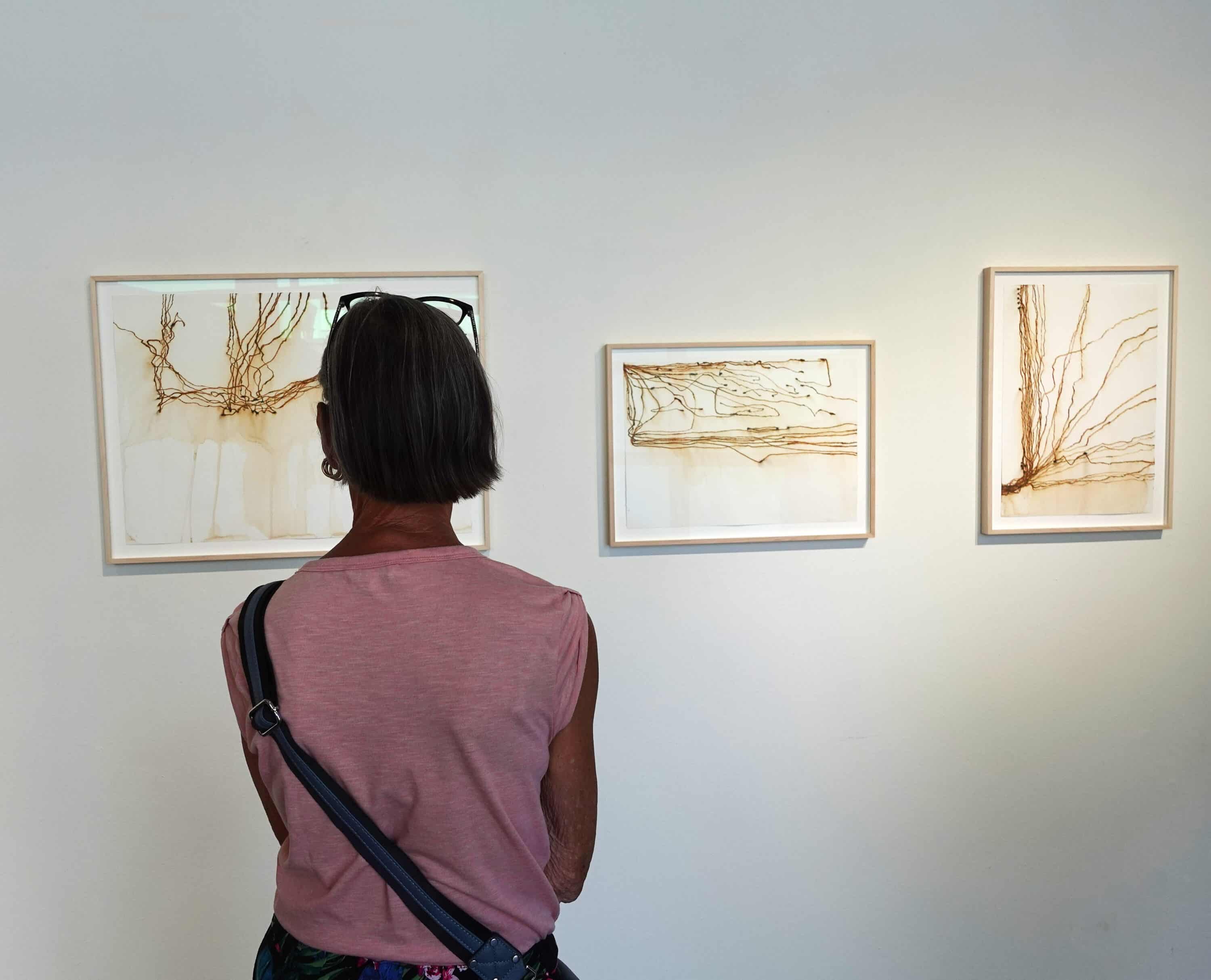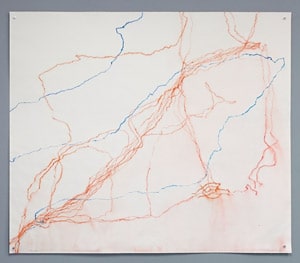On this page we took you on our journey during our residency at Drawing Centre Diepenheim from April until June 2024 – with an extension in July. We worked on a new series of Grazing Choreographies, this time Extra Large. The residency program is supported by the Mondrian Fund.
This blog is mainly in English. However, the audio files are in Dutch. In these audio files, we talk about the day’s drawing. In time, there will be a transcription and a translation.
July 11 2024
Today will be our last day since we planned to make twenty drawings, four at each farm. The same group of cattle moved to another meadow, so we set up on the silage heap. Also, today, the heifers were curious and stopped by at the fence where we were drawing to then continue to the water reservoir left on the drawing. Only in the last drawing they seemed to have lost their interest in us. So, only in this drawing does the group not gather in front of us but graze in two groups, one ending left above the drawing and the other leaving the paper on the right side.
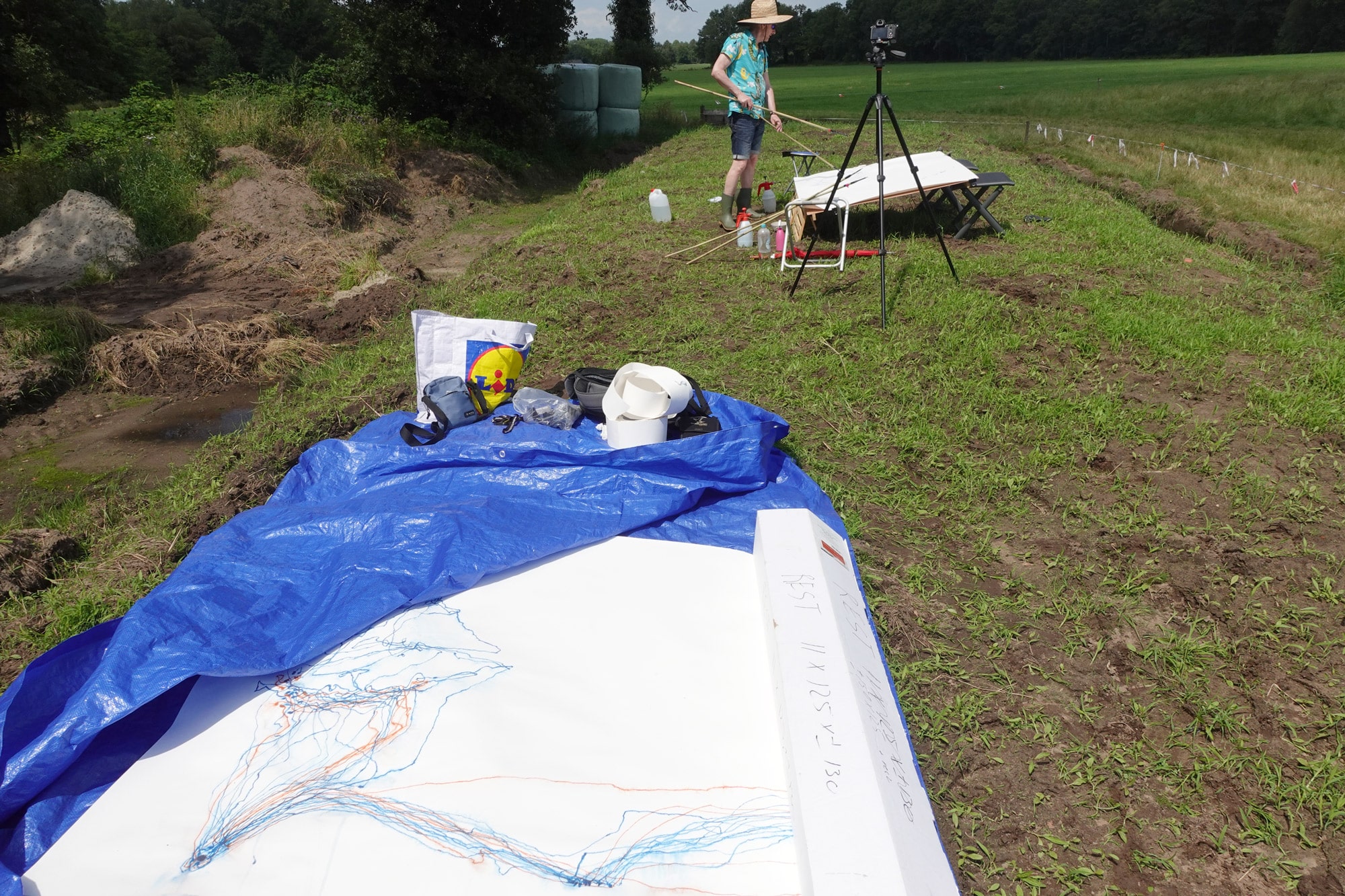
farm Ten Heggeler Drawing 19
farm Ten Heggeler Drawing 20
July 9 2024
After our two days (and four drawings) at the Heutinck farm, we went on the hunt for a more mixed herd of young cattle. The young cattle indeed, as we expected, behaved more as a group then the milk cows, which gives more intense end condensed line patterns. But we wanted a bit more color balanced group. Until now we had mainly red with one or two black, or the other way around. Janet Heilersig (from the Heilersig Farm), our super networker, connected us to yet another farmer through whom we ended up in our last location: the Ten Heggeler farm. Eighteen young cattle, heifers, five red and white. These were much more curious then at Heutinck’s and gathered close to the gate to watch us and get our attention. So that behaviour definitely influenced the drawings.
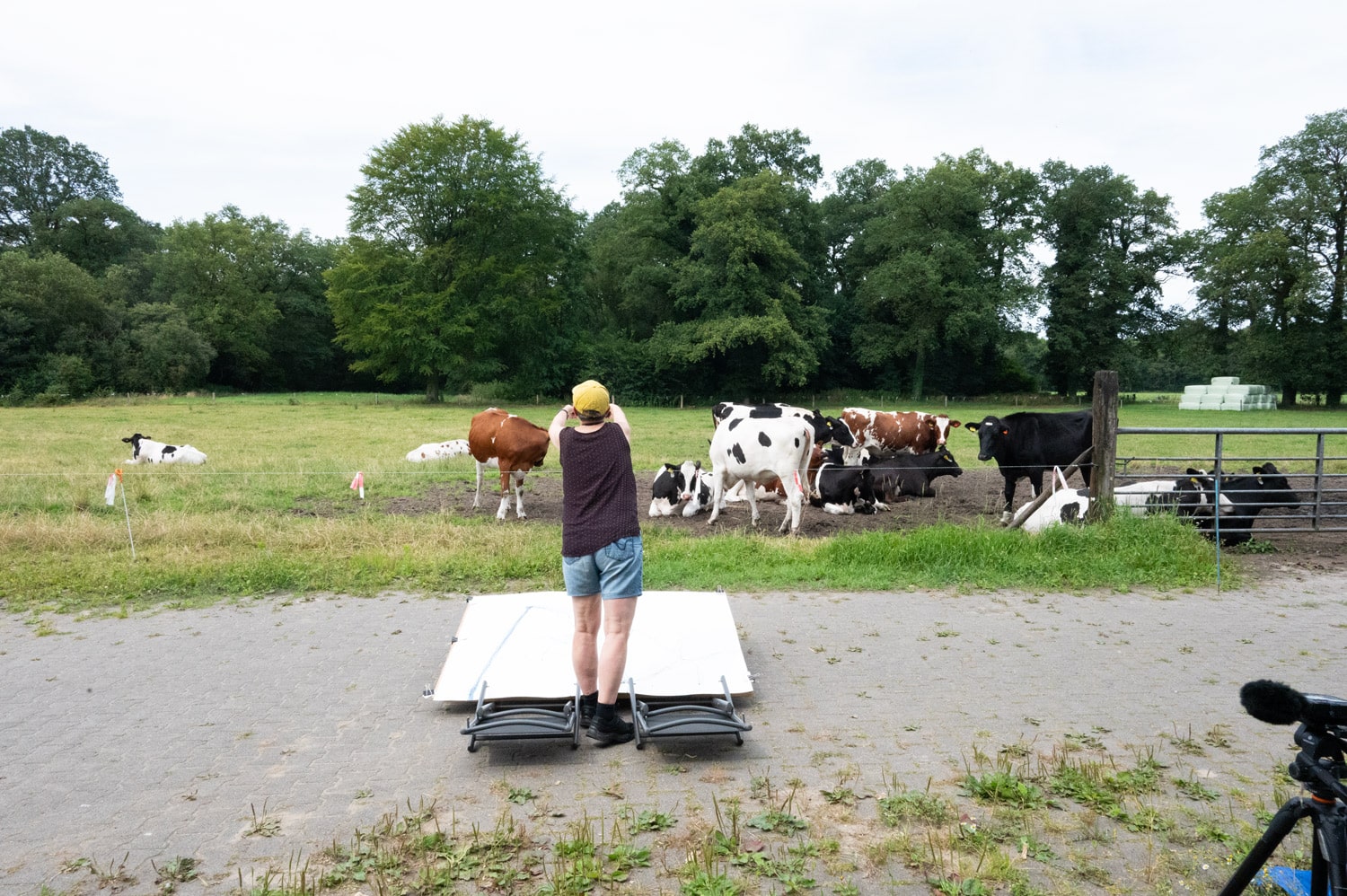
farm Ten Heggeler Drawing 17
farm Ten Heggeler Drawing 18
June 26 2024
The second day was spent at the meadow of Heutinck’s cattle. We choose the same spot, same direction, same framing of the field. In that way, we would end up with four drawings that would be comparable to each other, a sequence of sequences (since every drawing is a sequence of events in itself). This was also the first time we made a layout of the field on the drawing with small sticks, which you can see in the video. That helped us locate the cattle more accurately on the drawing. This set of four drawings we made yesterday and today demonstrates what Sannek Huisman wrote about Grazing Choreographies: ‘The map follows the user (in this case, the cow) who reveals fixed values through the trajectory covered. Through the subject, the viewer learns about the object’. Through the moving patterns of the cattle, you learn about drinking spots, fences, and gates or favorable ruminating spots. You see spots where the cattle gathers, where the lines come together or come to a halt – as a lived space. If you want more than to let your eyes glide over the image, lines, and blotted paint, then listen to the audio files, and you get some clues on the topography of the field and our experience while drawing.
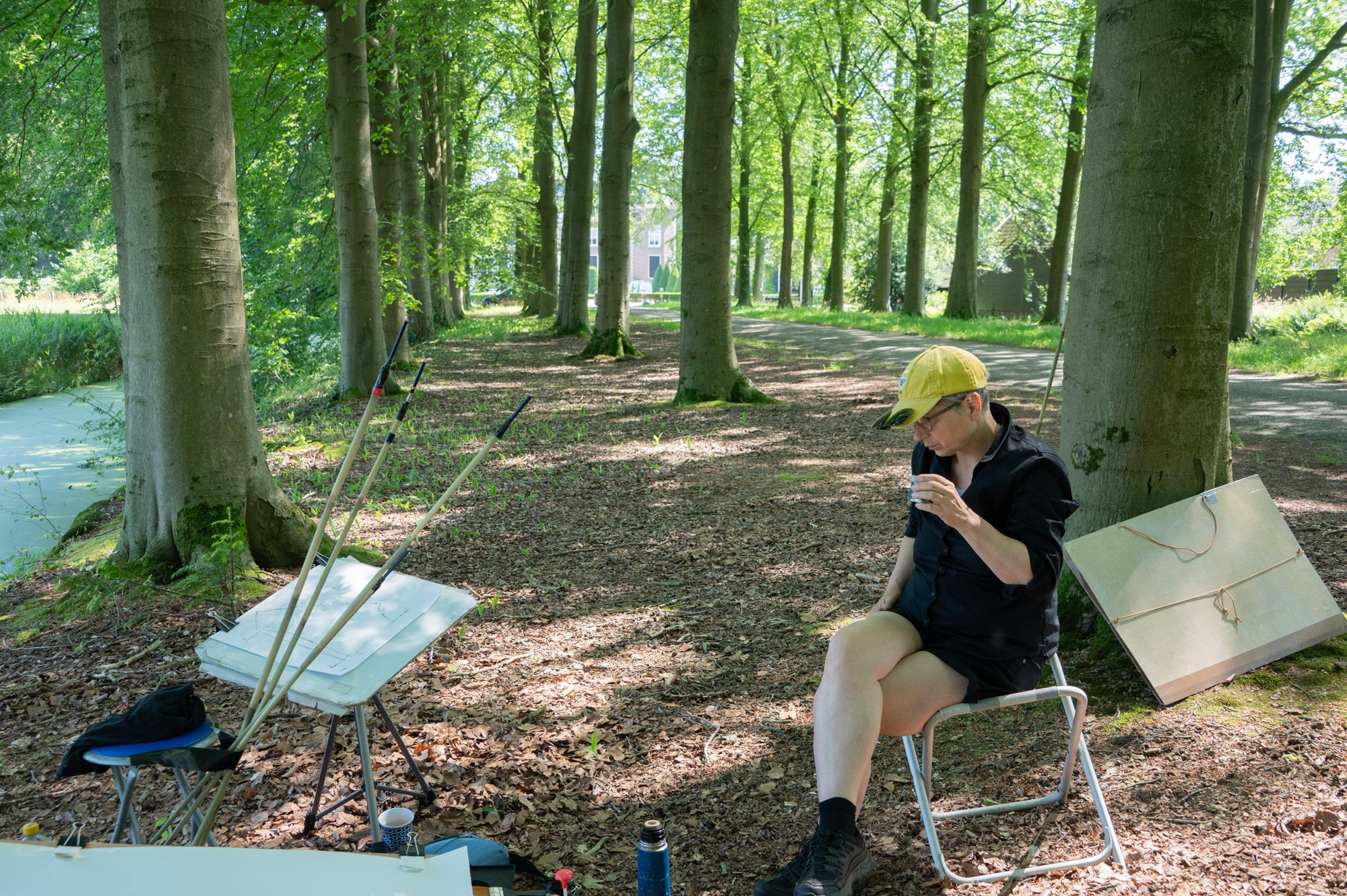
June 25 2024
On one of our biking trips we spotted a meadow with young, mainly plack and white, holstein cattle. That was what we were looking for! We hope and expect that young cattle graze in different patterns than milk cows for several reasons that we noticed in earlier drawing sessions in Tschlin (Switzerland) and Groningen. Firstly the young cattle isn’t milked so they don’t have to go inside, they’re outside 24/7, so they have no tendency to walk up to the gate to the milking parlour. Reasons for milk cattle to want to go inside: when it starts raining, when they hear whatever kind of action coming from the perimeter of the milking parlour, when someone shows up at the gate, when they rather be fed silage (fermented grass, corn, brewer’s grains etc), when they want to be milked (which plays a role when the farmer uses a milking robot).
Anyway, this turned out to be cattle from farmer Heutinck. We went over and asked if he minded that we would draw the grazing patterns of the cattle. Which was not a problem as long as we would’t go into the meadow, which was indeed not our intention. And so we set ourselves up for a new set of drawings.

farm Heutinck Drawing 13
farm Heutinck Drawing 14
June 13 2024
It was already a week ago again that we were at the Heilersig farm for the first time to draw. Today, for the first drawing, we again decided to draw the path so we could get another stream of cows walking towards the barn. In the video you see them pass by in between the camera and us. Ivar asked Aarnt-Jan if there would be fewer cows in the other meadow that afternoon because he would like to make a drawing with less cows, because he can be more precise, it’s a different focus. So Aart-Jan left a small group, but still nineteen, outside for us to draw.

farm Heilersig Drawing 11
farm Heilersig Drawing 12
June 8 2024
Today we had open studios at the Tekentuin Festival (Drawing Garden Festival) organized by the Drawing Centre. Esther welcomed som eighty visitors during the day.
Photo’s by Jeffrey van Houten for Drawing Centre Diepenheim
June 6 2024
Today is our first visit to the farm of Aarnt-Jan, Janet, and Emmy Heilersig in Markelo. Their cows only went outside last week since it had been raining so much. They introduced the milking robot only last December, so the cows still have to get used to their autonomous life – they can decide when to go back in to get milked. The Heilersigs use the New Dutch Pasture (Nieuw Hollands Weiden) system, in which the cows get a different plot of land every day of the week. Today they should be in field 2, but they broke out to field 3, so we set up our drawing table in field 2. About 105 cows. This will be a day of grazing system drawing more then following individual cows.
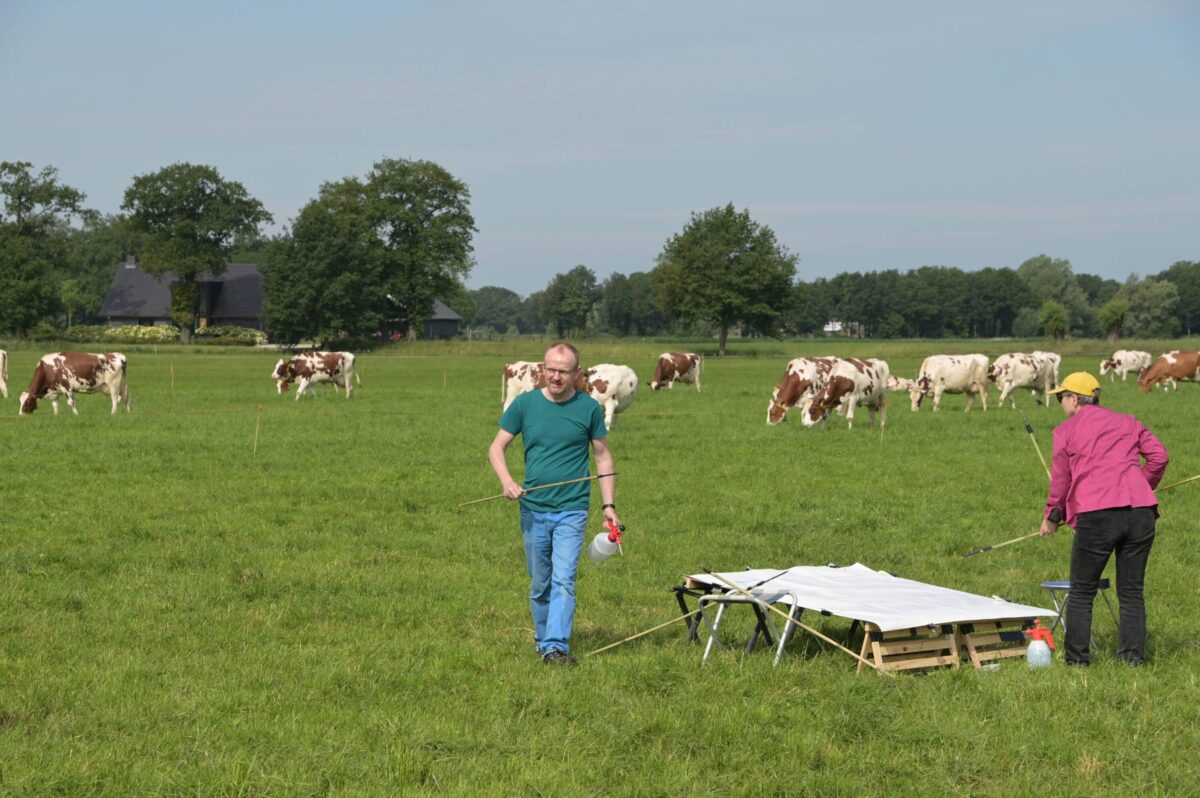
farm Heilersig Drawing 9
farm Heilersig Drawing 10
June 1 2024
The day before yesterday, we hung six of our new large grazing choreography drawings on the wall—preparing for the Drawing Garden Festival next week and for some studio visits, but not least to see what story they tell together and to feel what they actually evoke. Preparing, drawing, and processing them is such concentrated work that it’s a pleasure to see them all together on the wall.
We now know we definitely want to make at least six more in the coming month. So today preparing the drawing sheets and cardboard for drying needs to be done!
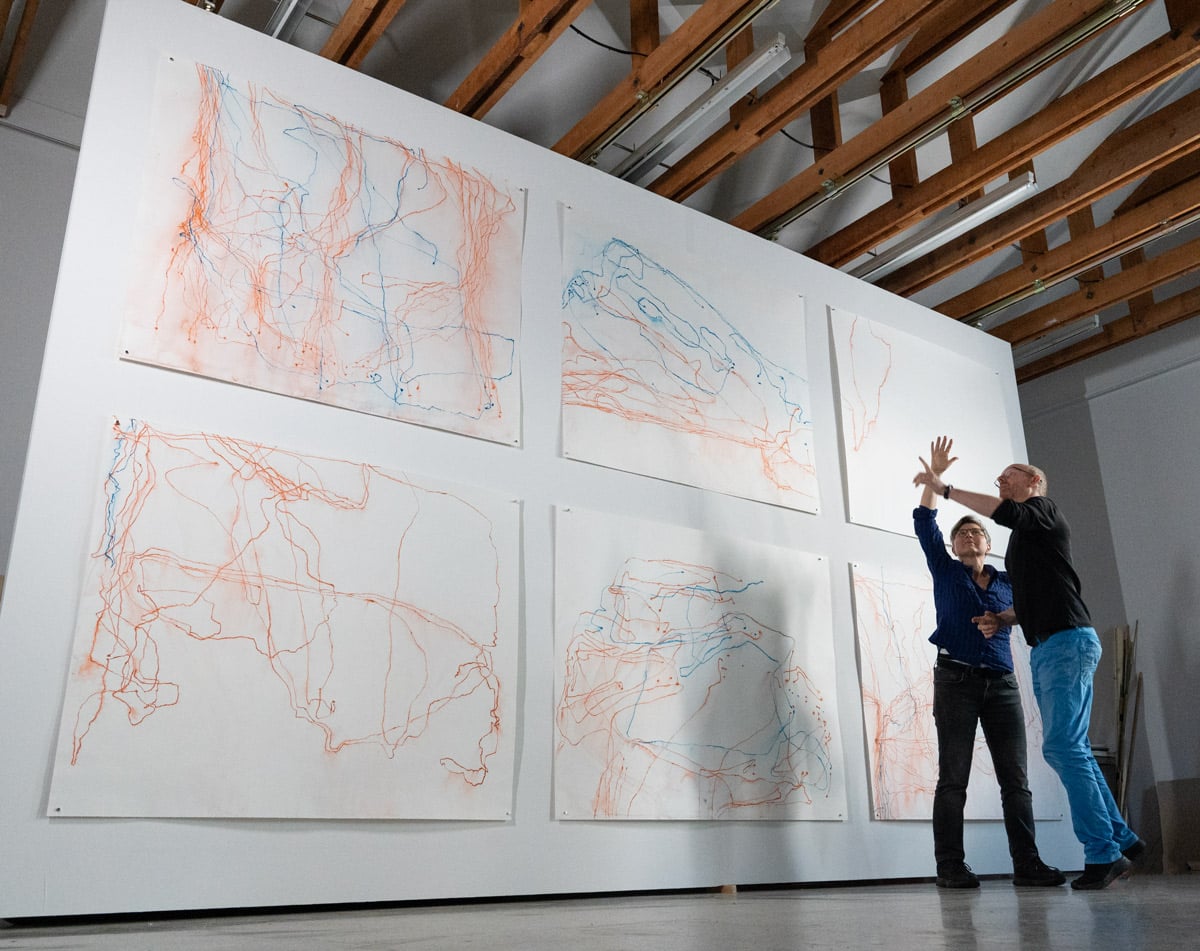
May 25 2024
It had been raining again severely, so the cows at the Meutstege had to stay inside the barn. We called Janette and Arend Jan in Markelo, but they did not have their cows out either. We expected Gerard Wissink to have their cows in the field, and indeed, that was the case. It was a different field than last time, but still adjacent to the corn silage.
In our first drawing, only two cows wanted to enter the stage. We waited for a while and then decided to start a new drawing, but still, we had to wait a while before they started to move towards our projected field. Soon almost all stood up and started to graze. Esther and I both followed black and reds, constantly switching pencils.
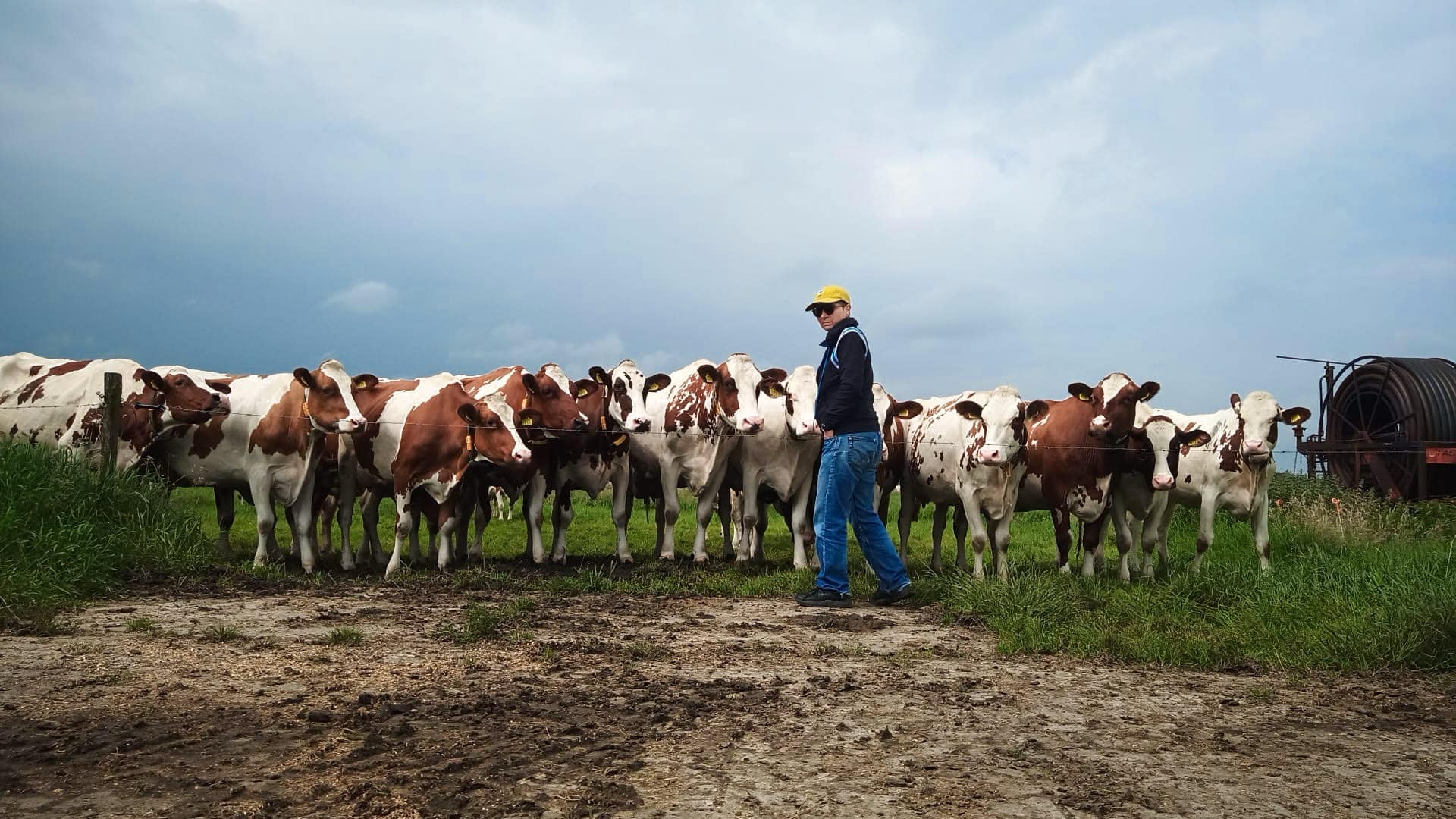
farm Wissink Drawing 7
farm Wissink Drawing 8
May 23 2024
Today, I went for fieldwork on my own, again at farm Meutstege. Esther sprained her ankle yesterday night on a drain in the pavement. So she has to keep calm for a few days. The cows were grazing on another part of the farmland—a rather strange shaped kind of plot, but next to the silage hump. So I was about 3 meters above the meadow and had a good view. As you can see in the stop-motion film of the first drawing, I had a good amount of backwind. In the end, the drawing pulled itself loose from the clamps and flipped over, leaving some wrinkles. I trust those will mostly straighten again. And hey, it’s fieldwork (I relied on my ‘tying up optimism,’ as Esther calls it).
For the second drawing, I turned to a square part of the field to make it easier to project the field on the paper. Compared to last Tuesday, the plot of land for both drawings was relatively minor. Hence, the distances on the paper were smaller, and cows moved significantly faster compared to the paper size. For more cartographic-minded readers, this is as if the cows moved from a 1:50000 map to a 1:10000 map without telling me.
Barend, the farmer’s father and former owner of the farm, warmheartedly brought me a coffee and a cookie. We talked for a bit about the land, the cows, the milk, and the bugs that cause the blue tongue virus, about politics regarding agriculture and the fact that change always takes place at its own pace.
farm Meutstege Drawing 5
farm Meutstege Drawing 6
May 21 2024
Another day at the farm! This time, we set up camp at the farm of Arjen and Karin Meutstege in Diepenheim. We found ourselves a good spot in the shadow, with little wind. Most of the cows also found the coolness of the shadow of the trees and were lying ruminating when we started drawing. Different from other times, we chose the whole field to be our drawing, except the top, where the cattle could leave the drawing. The left, right, and bottom were fenced off, though.
We made two drawings today. Before setting for our first drawing on April 27, we decided to use two different colors: one for the red-pied and one for the black-pied Holsteins. Also, like in Markelo, this herd has more red-pied than black-pied Holstein cattle. In the second drawing, just one black-pied cow entered and later left the part of the meadow we chose to draw.
farm Meutstege Drawing 3
farm Meutstege Drawing 4
May 17 2024
Opening the exhibition Tidings from the Two Dimensional (Berichten uit het Platte Vlak). Mieke Conijn (director of Kunstenlab) opened the exhibition program (our en Zeger Reyers exhibition), and Noa Zuidervaart (artistic leader of Drawing Centre Diepenheim) opened our exhibition by talking about the day he visited our studio (the essay he based his speech on (in Dutch) you can read here). In the exhibition exixting and new Grazing Choreographies, Water Drawings from the IJssel river, Walking the Machine and Pi-Boy.
Met veel dank aan de inzet van het volledige team van Kunstenlab en Diepenheim.
Photos of the opening by Viorica Cernica
May 16 2024
For the new drawings in our exhibition in Kunstenlab (made in Markelo), which are not in our book Grazing Choreographies, we made a short audio file. We did the same for the Water Drawings made at the banks of the river IJssel (IJsseloever)
May 15 2024
Amidst of the Tschlin (S) and Feerwerd (NL) Grazing Coreographies our freshly drawn Markelo Grazing Choreographies (150x125cm). With the signs still taped to the wall. Progress is being made.

Drawings are hanged. The two larger ones are made in Markelo; see the post on 27th April.
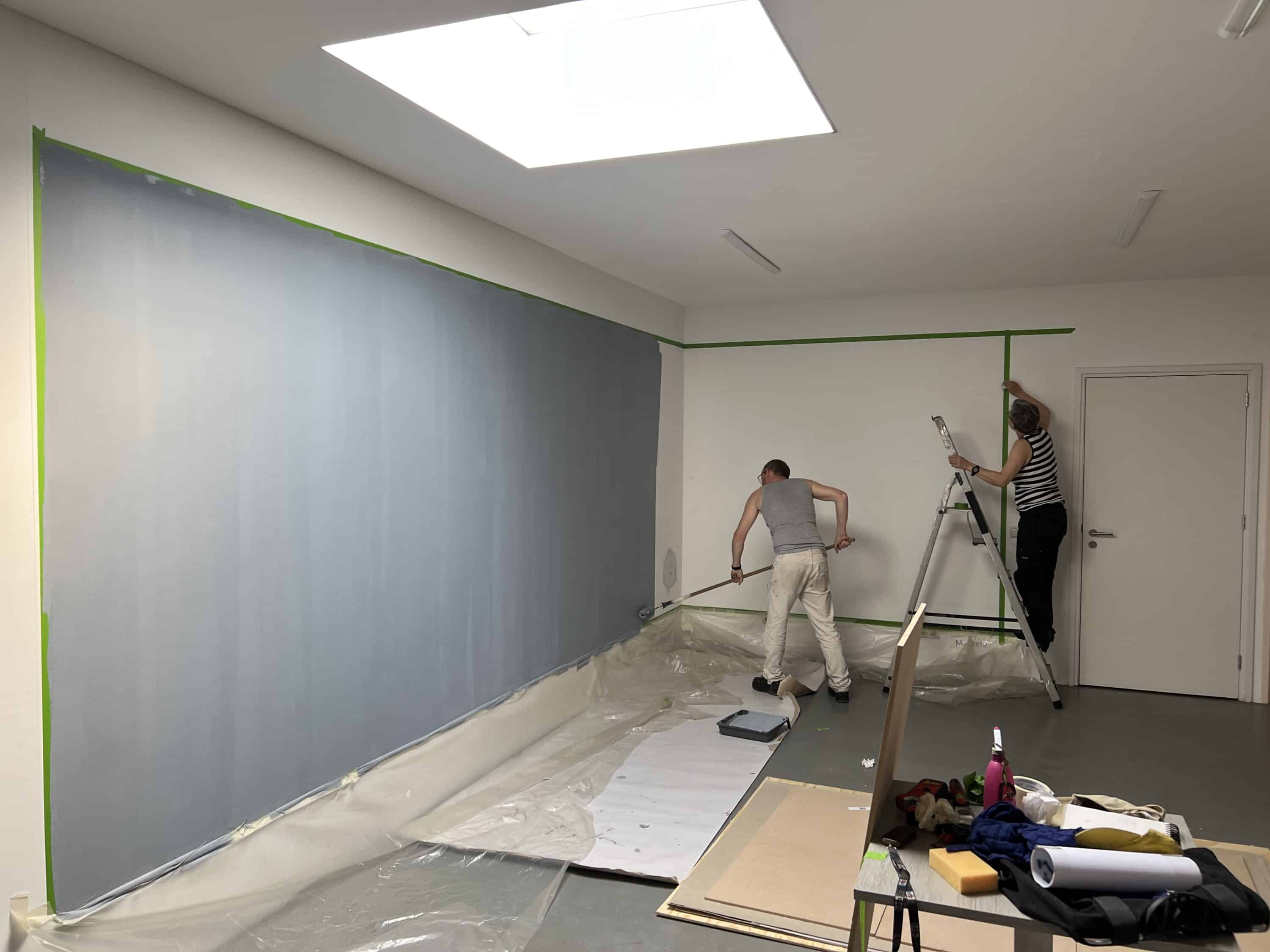
Photo: Zeger Reyers
May 12 2024
Setting up our solo Tidings from the Two-dimensional at Kunstenlab.
April 29 2024
We took our initial step: the first day of drawing the large-format grazing choreographies. This spring, we had to wait a long time; the pastures around Diepenheim were still too wet to let the cattle out. Gerard and Anja Wissink already have their (mostly) red and white pied Holsteins outside; their pasture is just a bit higher because of the impoundment by glacier ice in the Markelo area. We were allowed to draw from the mound of silage corn: a great spot, giving us a good overview of the herd.
farm Wissink Drawing 01
En Plein Air Drawing; large size number one in Markelo, Overijssel Netherlands
farm Wissink Drawing 2
En Plein Air Drawing; large size number two in Markelo, Overijssel Netherlands

En Plein Air Drawing; large size
April 08 2024
Our first week at Drawing Centre Diepenheim: The reading table is set. I begin with this classic: John Berger’s “Far Away in Europe,” where he captures his French countryside experience in beautiful fiction. With the exception of a very lucid essay, he characterizes the countryside’s mentality as that of survivors. And then not “staying alive” in the sense of reaching old age, but sustain one’s peasant existence within the exchange between landscape, climate, belongings, and knowledge transmitted from generation to generation.
April 01 2024
Since the publication of our book Grazing Choreographies, we have felt the need to develop this way of drawing further on a larger format paper. With the experience of the earlier drawings, we want to engage ourselves with monumental landscapes, both in execution and presentation. It is vital for us to create a series of drawings that together form a strong spatiality.
We want to connect with local farmers during our residency. Drawing on a large format requires that connection. Both practically and in terms of content, we are out there with a large installation, and that is only possible if we are welcome and engage in conversation. These encounters will be reflected in the writings that accompany each drawing.
We look forward to finding this opportunity in the rural East of the Netherlands at Drawing Centre Diepenheim.
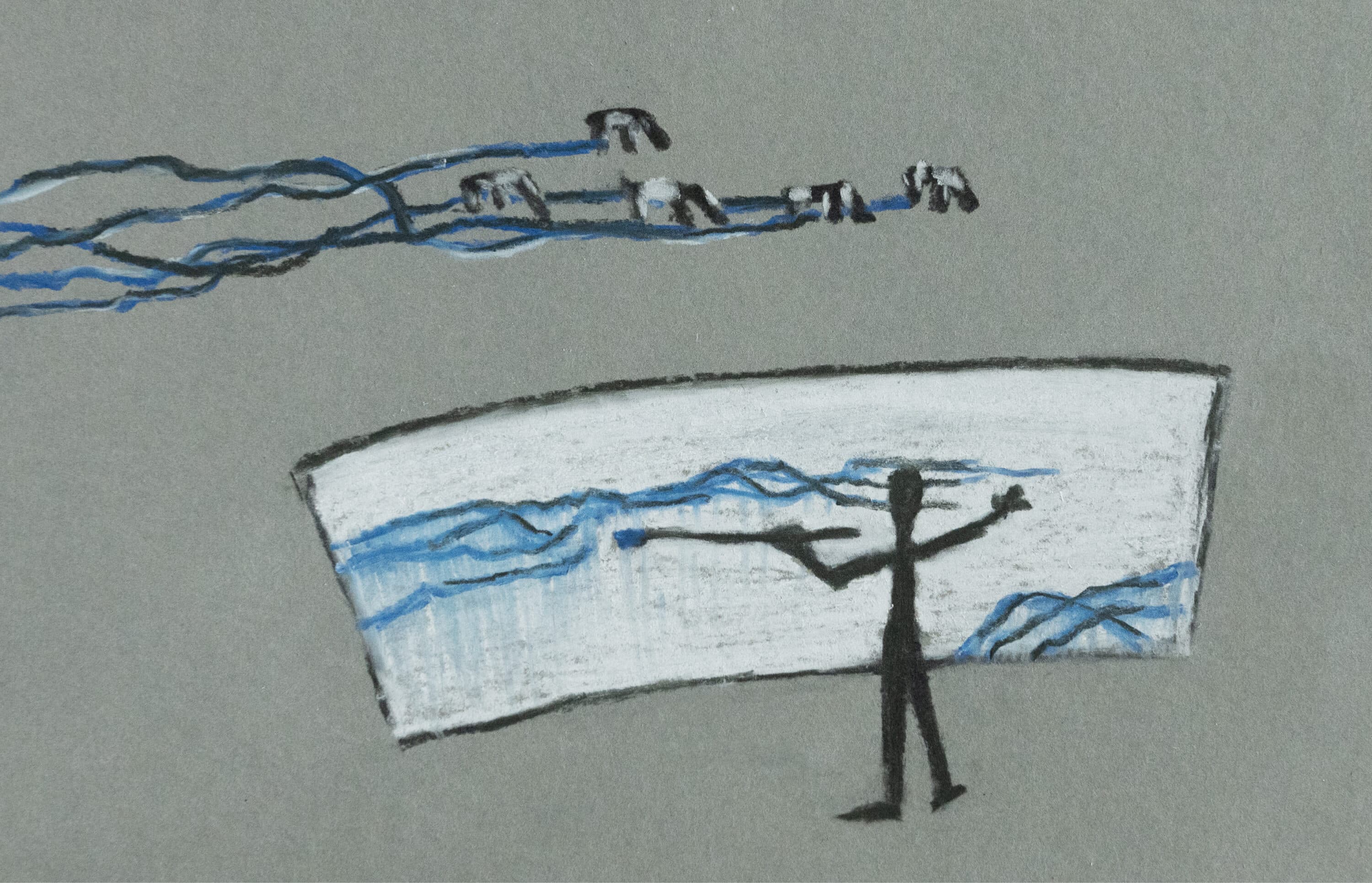
En Plein Air Drawing; large size
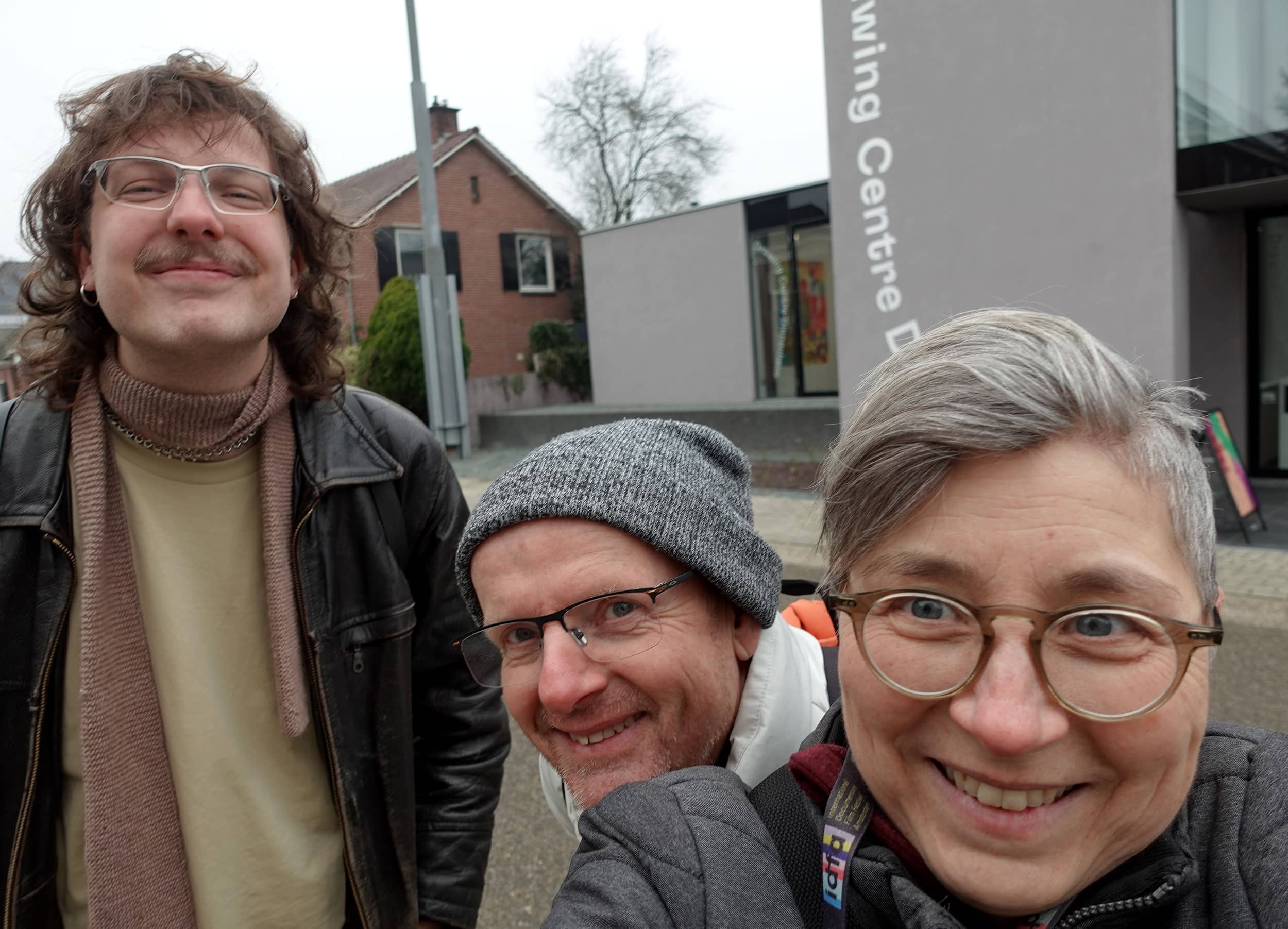
Noa Zuidervaart (artistic director Drawing Centre Diepenheim), Ivar van Bekkum and Esther Polak in front of the Drawing Centre.
January 11 2024
We visit the Drawing Centre two and a half months before the start of or residence to prepare for our stay. Noa, the artistic director, gave us a tour and contact numbers, so we could already meet some of the staff members and some local farmers.
Our work focuses on movement and landscape and how mobility shapes the landscape. Just over twenty years ago, this began with innovative artistic experiments with location technology (particularly GPS) as a means of recording movement. This often resulted in digital prints or animations of traveled routes. We saw this as a ‘photography of movement’. Within this experimental practice, we have looked for opportunities to use technology as a tool to provide a representation of the landscape as it emerges from movement. Our most recent move has been to create drawings that, while stemming entirely from those experiments with technology, are completely free of the technology itself in their execution.
With Grazing Choreographies, we now draw directly, trusting our human powers of observation, the movements we would have previously captured with GPS.
